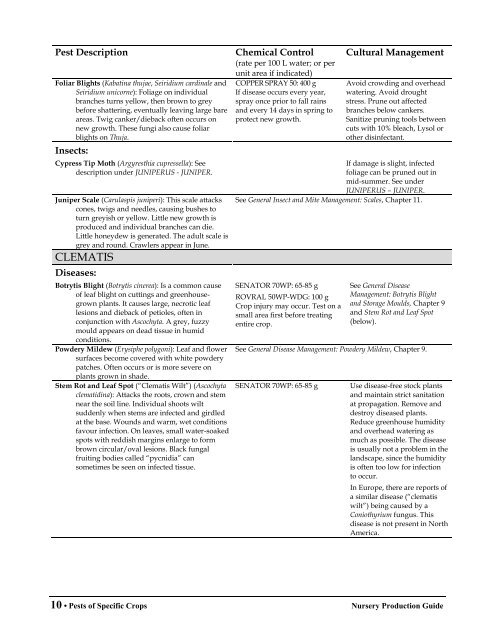Create successful ePaper yourself
Turn your PDF publications into a flip-book with our unique Google optimized e-Paper software.
Pest Description<br />
Foliar Blights (Kabatina thujae, Seiridium cardinale and<br />
Seiridium unicorne): Foliage on individual<br />
branches turns yellow, then brown to grey<br />
before shattering, eventually leaving large bare<br />
areas. Twig canker/dieback <strong>of</strong>ten occurs on<br />
new growth. These fungi also cause foliar<br />
blights on Thuja.<br />
Insects:<br />
Cypress Tip Moth (Argyresthia cupressella): See<br />
description under JUNIPERUS - JUNIPER.<br />
Juniper Scale (Carulaspis juniperi): This scale attacks<br />
cones, twigs and needles, causing bushes to<br />
turn greyish or yellow. Little new growth is<br />
produced and individual branches can die.<br />
Little honeydew is generated. The adult scale is<br />
grey and round. Crawlers appear in June.<br />
CLEMATIS<br />
Diseases:<br />
Botrytis Blight (Botrytis cinerea): Is a common cause<br />
<strong>of</strong> leaf blight on cuttings and greenhousegrown<br />
plants. It causes large, necrotic leaf<br />
lesions and dieback <strong>of</strong> petioles, <strong>of</strong>ten in<br />
conjunction with Ascochyta. A grey, fuzzy<br />
mould appears on dead tissue in humid<br />
conditions.<br />
Powdery Mildew (Erysiphe polygoni): Leaf and flower<br />
surfaces become covered with white powdery<br />
patches. Often occurs or is more severe on<br />
plants grown in shade.<br />
Stem Rot and Leaf Spot (“Clematis Wilt”) (Ascochyta<br />
clematidina): Attacks the roots, crown and stem<br />
near the soil line. Individual shoots wilt<br />
suddenly when stems are infected and girdled<br />
at the base. Wounds and warm, wet conditions<br />
favour infection. On leaves, small water-soaked<br />
spots with reddish margins enlarge to form<br />
brown circular/oval lesions. Black fungal<br />
fruiting bodies called “pycnidia” can<br />
sometimes be seen on infected tissue.<br />
Chemical Control<br />
(rate per 100 L water; or per<br />
unit area if indicated)<br />
COPPER SPRAY 50: 400 g<br />
If disease occurs every year,<br />
spray once prior to fall rains<br />
and every 14 days in spring to<br />
protect new growth.<br />
Cultural Management<br />
Avoid crowding and overhead<br />
watering. Avoid drought<br />
stress. Prune out affected<br />
branches below cankers.<br />
Sanitize pruning tools between<br />
cuts with 10% bleach, Lysol or<br />
other disinfectant.<br />
If damage is slight, infected<br />
foliage can be pruned out in<br />
mid-summer. See under<br />
JUNIPERUS – JUNIPER.<br />
See General Insect and Mite Management: Scales, Chapter 11.<br />
SENATOR 70WP: 65-85 g<br />
ROVRAL 50WP-WDG: 100 g<br />
Crop injury may occur. Test on a<br />
small area first before treating<br />
entire crop.<br />
See General Disease<br />
Management: Botrytis Blight<br />
and Storage Moulds, Chapter 9<br />
and Stem Rot and Leaf Spot<br />
(below).<br />
See General Disease Management: Powdery Mildew, Chapter 9.<br />
SENATOR 70WP: 65-85 g<br />
Use disease-free stock plants<br />
and maintain strict sanitation<br />
at propagation. Remove and<br />
destroy diseased plants.<br />
Reduce greenhouse humidity<br />
and overhead watering as<br />
much as possible. The disease<br />
is usually not a problem in the<br />
landscape, since the humidity<br />
is <strong>of</strong>ten too low for infection<br />
to occur.<br />
In Europe, there are reports <strong>of</strong><br />
a similar disease (“clematis<br />
wilt”) being caused by a<br />
Coniothyrium fungus. This<br />
disease is not present in North<br />
America.<br />
10 • <strong>Pests</strong> <strong>of</strong> <strong>Specific</strong> <strong>Crops</strong> Nursery Production Guide
















